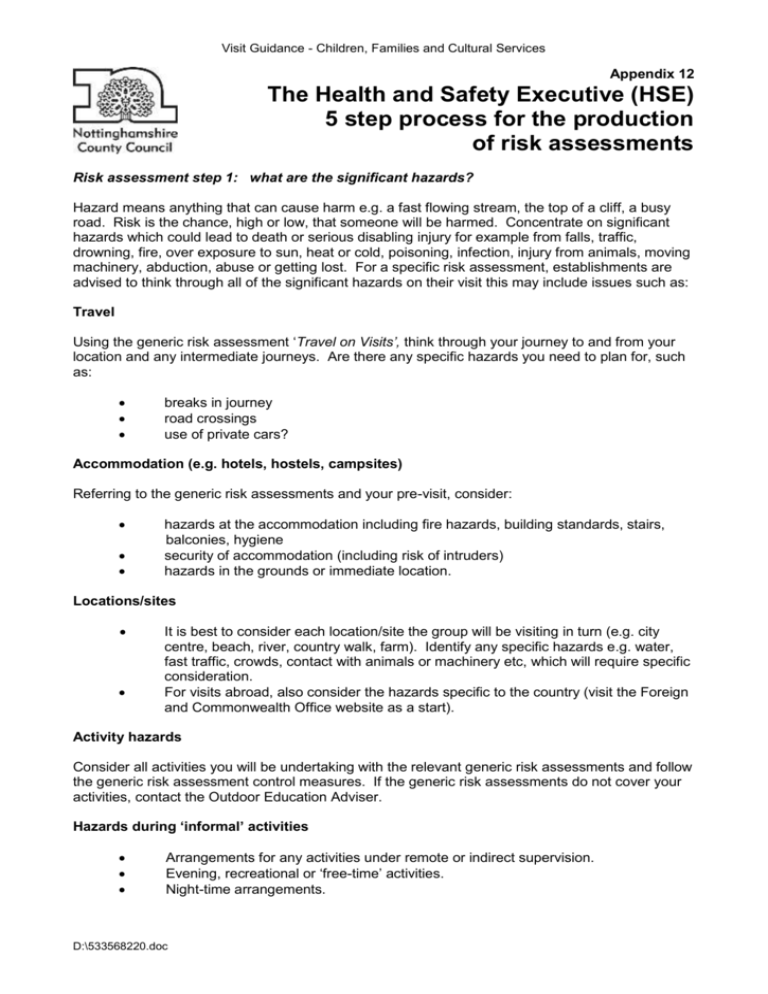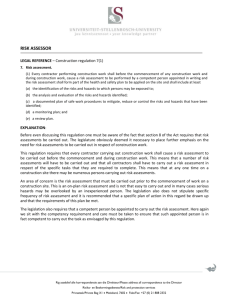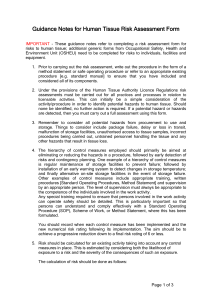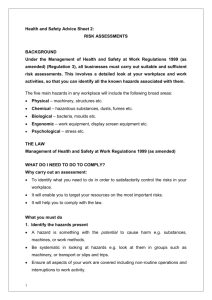5 step process for the production of risk assessments
advertisement

Visit Guidance - Children, Families and Cultural Services Appendix 12 The Health and Safety Executive (HSE) 5 step process for the production of risk assessments Risk assessment step 1: what are the significant hazards? Hazard means anything that can cause harm e.g. a fast flowing stream, the top of a cliff, a busy road. Risk is the chance, high or low, that someone will be harmed. Concentrate on significant hazards which could lead to death or serious disabling injury for example from falls, traffic, drowning, fire, over exposure to sun, heat or cold, poisoning, infection, injury from animals, moving machinery, abduction, abuse or getting lost. For a specific risk assessment, establishments are advised to think through all of the significant hazards on their visit this may include issues such as: Travel Using the generic risk assessment ‘Travel on Visits’, think through your journey to and from your location and any intermediate journeys. Are there any specific hazards you need to plan for, such as: breaks in journey road crossings use of private cars? Accommodation (e.g. hotels, hostels, campsites) Referring to the generic risk assessments and your pre-visit, consider: hazards at the accommodation including fire hazards, building standards, stairs, balconies, hygiene security of accommodation (including risk of intruders) hazards in the grounds or immediate location. Locations/sites It is best to consider each location/site the group will be visiting in turn (e.g. city centre, beach, river, country walk, farm). Identify any specific hazards e.g. water, fast traffic, crowds, contact with animals or machinery etc, which will require specific consideration. For visits abroad, also consider the hazards specific to the country (visit the Foreign and Commonwealth Office website as a start). Activity hazards Consider all activities you will be undertaking with the relevant generic risk assessments and follow the generic risk assessment control measures. If the generic risk assessments do not cover your activities, contact the Outdoor Education Adviser. Hazards during ‘informal’ activities Arrangements for any activities under remote or indirect supervision. Evening, recreational or ‘free-time’ activities. Night-time arrangements. D:\533568220.doc Visit Guidance - Children, Families and Cultural Services Note that these are the times when most incidents occur and supervision levels are most likely to be questioned. Therefore, it is vital to ensure that these times are properly planned and that adequate control measures are in place. Medical, behavioural and special needs Individual specific educational or medical needs (take advice from the establishment's special needs coordinator and from parents via a parental consent form) some individual participants with special needs may have, or may require, their own specific risk assessment. Illness or injury, particularly if this could occur away from immediate medical assistance. If abroad, health hazards specific to the country to be visited. Supervision of the group The age and ability of the participants – the control measures will include the number and competence of staff required and rules for behaviour. If indirect or remote supervision is proposed (e.g. souvenir shopping), the specific control measures should include the plan for this. Issues of child protection and personal safety. Homes used for exchange visits. Other significant hazards specific to the visit Refer to any similar previous visits and any ‘near-miss’ reports held by the VC. Consider if there are any other significant hazards not covered above. Changeable factors –alternative plan E.g. if weather could affect the programme, control measures should include obtaining a forecast and being able to change plans if necessary; include an alternative ‘Plan B’ which is also risk assessed. Emergency plan Incident or emergency - control measures should include a planned emergency procedure. Sensible standard emergency plans would include access to a first aider and first aid materials, having a means of communication and access to contact numbers. Further guidance on action in the event of an emergency is contained in section 11. Risk assessment step 2: who might be at risk? Consider: participants leaders other people. Risk assessment step 3: evaluate the hazards and risks and decide what needs to be done to reduce the risks to an acceptable level. What control measures need to be in place before the visit? These may include: D:\533568220.doc Visit Guidance - Children, Families and Cultural Services following the LA policy for visits and generic risk assessment control measures, relevant procedures of the establishment and, if abroad, following Foreign Office advice relevant establishment policies and procedures (for example a school’s behaviour policy, emergency plan or lone worker guidelines) ratios, experience and training of staff, including first aid specific supervision arrangements for the visit (how staff will be deployed) specific knowledge of area to be visited, pre-visit and check of locations and providers flexibility to change programme, an alternative plan B, if circumstances dictate planned emergency procedures briefing of leaders, participants and parents other controls. What further control measures or actions are needed before, at the start of, or during the visit? These may include: check of participants’ equipment and clothing daily review of weather and programme briefing of leaders briefing and monitoring of participants other measures specifically required for the visit. e.g. if in or near water, review of water levels and weather forecast. The control measures specified in the risk assessment must be followed in preparation for and undertaking the visit. After considering the control measures, is the residual risk acceptable or not? If not, more needs to be done or the programme altered accordingly. Risk assessment step 4: record your findings A template for specific risk assessments is available for establishments to use. Establishments should use this form as a planning tool to identify significant hazards and actions to be taken. For regular visits, establishments can develop a portfolio of specific risk assessments and, if helpful, a code of practice for running these visits. For these regular visits these risk assessments can then be referred to for each visit rather than rewritten every time it occurs. All leaders, participants, parents and guardians should be aware of the risk assessments and control measures relevant to them. Visit leaders should provide other leaders with copies of the risk assessments, using the risk assessment proforma to identify who needs to be informed of what, and ensure they are appropriately briefed on procedures for the visit Risk assessment step 5: reviewing your assessment Generic and specific risk assessments must be reviewed before every visit. This ensures leaders are familiar with the hazards and control measures and provides a check that circumstances have not changed and that the risk assessment needs amendment. It is good practice that risk assessment portfolios are reviewed annually. Risk assessments should also be amended as a result of any relevant learning outcomes from visits or any unforeseen occurrence. Training support for the production of risk assessments is available directly from the Outdoor Education Advisors or the Safety Advisers team. D:\533568220.doc






